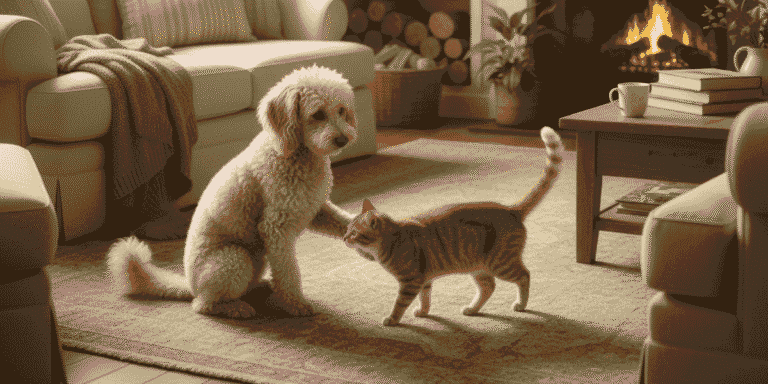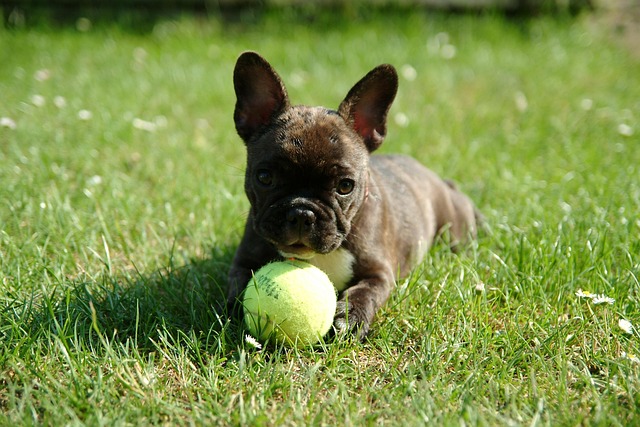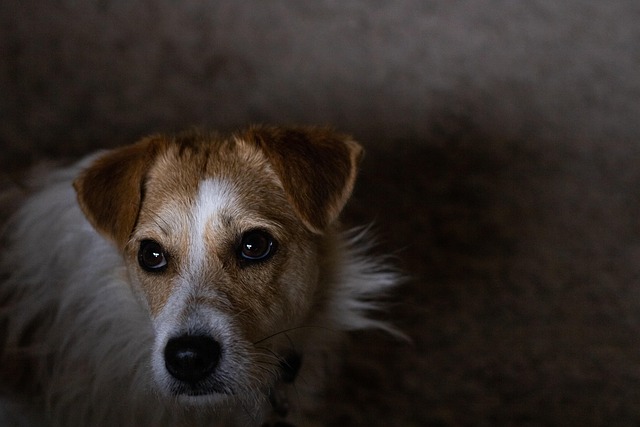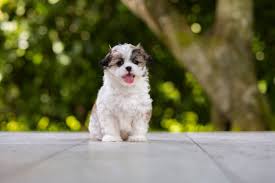It is known for its rare two-tone coat pattern, which exhibits color points on the ears, snout, and other body areas. The average phantom poodle will have one predominant color, usually black or brown.
They usually have white markings over their eyes, chest, legs, and tails. This trend is especially pronounced in standard, mini, and toy poodles.
Here in the United States, phantom poodles fulfill those health and grooming requirements just like any other colored poodle. Their unique appearance tends to turn heads more at dog parks.
Color, clarity, and evenness of markings are essential, especially for show-quality dogs. Learn why phantom poodles are all the rage and how they find their place in American households.
What is a Phantom Poodle?

Phantom Poodles are instantly recognizable because of their distinctive markings of tan and brown colors on the coat, making them different from all other Poodle types. Unlike solid-colored or Parti Phantom Poodles, Phantom Poodles display a bi-colored or tri-colored pattern.
These markings produce the appearance of gentle shadows or “phantoms,” which gave rise to their name. The pattern is not coincidental; it has a very distinct arrangement on the dog’s body. Identifying these characteristics is crucial to understanding how Phantom Poodles stand out from others in the breed.
1. Decoding Phantom Markings
Phantom markings appear in set spots—above the eyes, on the sides of the muzzle, chest, legs, and under the tail. These placements are similar to the Doberman’s “Dobie markings,” rendering Phantom Poodles with a distinguished, watchful appearance.
Unlike Parti or TUX Poodles that have patches, Phantom markings are never random and always occur in these precise areas.
Common marking spots:
- Eyebrows
- Sides of muzzle
- Chest
- Legs (front and back)
- Under the tail
2. It’s a Pattern, Not Breed
Phantom is a color pattern, not a separate breed. You’ll see it in Toy, Miniature, and Standard Poodles. The pattern is produced by a recessive trait, requiring the ky/ky genotype for the markings to be expressed.
Even with their flashy appearance, Phantom Poodles are still standard Poodles in every other way. Only their coat gives them away.
3. Striking Color Duos
The majority of Phantom Poodles have a dark colored base – such as black – with rust, apricot or cream markings. The main categories are:
| Base Color | Marking Color | Prevalence |
|---|---|---|
| Black | Tan | Very common |
| Chocolate | Tan | Common |
| Red | Apricot | Less common |
| Silver | Cream | Rare |
Their striking color duos and sharp contrast make them a crowd favorite on the show circuit and between fandoms.
4. Official Breed Standard View
The American Kennel Club (AKC) recognizes Phantom Poodles as a legitimate breed variation. Yet, they don’t permit these color combinations in the conformation show ring.
The United Kennel Club (UKC) is somewhat more progressive, allowing a wider variety of patterns to be shown. These standards are intended to provide clear guidance to breeders and clear expectations to new owners.
5. My First “Phantom” Sighting
Right off the bat, the vivid markings are what stand out. They do provide the poodle with a masked, noble appearance. Just ask any of the owners, who report their first sighting igniting a deep desire to know more.
Share your story in the comments below.
Phantom Poodle Puppies Unveiled

Phantom Poodle puppies are especially impressive due to their unique coat pattern, characterized by their phantom poodle colors. They possess a strong base color, usually black, brown, or silver, with clear-cut secondary color markings over the eyes, on the muzzle, chest, and legs. These distinctive markings make them look like petite Dobermans and are caused by specific genetic combinations influenced by the dilution gene. That flashy, show-stopping appearance sure is a head-turner!
This breed’s intelligence and energetic disposition contribute to their surging popularity with American dog owners. Welcoming one of our Phantom Poodle puppies into your home is about so much more than just adding an adorable new member to your family. These puppies grow into spirited companions whose silly, affectionate natures and trainability will keep you on your toes, making them a great choice for those interested in phantom poodle behavior.
Most owners report that these puppies do best in active households and thrive with socialization. Recently, their popularity has skyrocketed as more and more people seek out their unique appearance and vivacious spirit. Choosing a responsible breeder is crucial. Reputable breeders test for genetic markers, significantly lowering the risk of genetic diseases, thus ensuring better overall phantom poodle care.
Here in the U.S., families will find Phantom Poodles in toy, miniature, and standard sizes. This diversity ensures that you can obtain the ideal match for their way of life! The name “Phantom” has a bit of mystique to it, appropriate for such a rare and unforgettable look in dogs. Increased demand equals more breeders.
With the increased demand, it’s inevitable that more breeders have started to offer Phantom Poodles. Going through reputable sources means better care for puppies, healthier puppies, and more ethical distribution methods. The historical allure, genetic background, and practical traits of Phantom Poodles make them a unique and rewarding choice for many American households.
The Rarity of Phantom Poodles

Phantom Poodles make for a great case study, both for their unusual color pattern and the intricate genetics underlying it. As such, their rarity is determined by genetics, selective breeding, and of course, cultural trends in what dog lovers are looking for.
In the past 15 years, people have become enamored with their impressive appearance. This demand has skyrocketed, particularly in cities, such as Los Angeles. Yet, their numbers remain few because of the specific actions required to produce them.
Genetics Behind the Markings
Phantom Poodles, as the name suggests, owe their name to the unique patterns found on their coats. This pattern is due to a unique combination of genes, most notably the ky/ky genotype.
Well, it’s not that simple. It is possible that the solid color gene, particularly black, masks the phantom pattern in earlier generations. That’s to say, even controlled breeding could produce non-phantoms, making every planned phantom litter more of a gamble.
To maintain the pattern’s clarity and intensity, breeders need to mate dogs with the appropriate genes, redoing and honing combinations over generations. This demand for meticulous design is what makes them such a rarity.
Breeder Choices and Supply
Breeders are one of the most influential factors in the number of Phantom Poodles that make it to market. Even though they all have the same temperament, until 2005, stringent regulations in countries such as Germany prevented breeders from crossing phantom with other colors.
Even in the present day, ethical breeders are concerned with health and temperament, as well as aesthetics. When the demand is higher for phantoms, some breeders are quick to respond to that demand.
Responsible breeders never lose sight of the importance of quality. By choosing to support these breeders, you’re doing your part to keep the breed healthy and the pattern authentic.
Are They Truly Uncommon?
Though Phantom Poodles are rarer than their solid or parti-colored counterparts, they are becoming more prevalent. As interest in them increases, urban U.S. Areas are experiencing an increasing presence of these magnificent creatures.
Genetic obstacles and intentional breeding keep their overall numbers low. The trend is certainly in that direction, but phantom Poodles are still a rarity among all types of Poodles.
My View: Niche, Not Unicorn
Phantom Poodles are indeed rare but not mythical creatures. They attract people looking for authenticity — for something alternative yet tangible.
Their combination of history, genetics, and flair creates a special niche that every dog lover should appreciate. It poses a challenge to view them as special, not unicorn.
Beyond Beauty: Phantom Temperament

In addition to their gorgeous color, Phantom Poodles are known for their glorious and noble temperament. Intuitive, intelligent, and loyal, these dogs are best served by an owner who understands their need for strong connections with their humans. Their temperament is more than skin deep.
It determines how well they integrate into our homes across the U.S. — from urban apartments to suburban single-family houses. Whether you’re considering bringing a Phantom Poodle into your home or just curious to learn more about this unique breed, understanding these characteristics is essential.
Smart, Trainable Companions
In terms of intelligence, Phantom Poodles are typically at the head of the class. They’re quick learners and love to learn new things. This eagerness to please makes them highly trainable, from basic behaviors to complex stunts.
Methods such as positive reinforcement—rewarding with treats, praising or playing with dogs—are proven to be the most effective. Change it up. Mental stimulation is key, as it helps them stay mentally healthy and engaged and helps avoid boredom.
Puzzle toys, brief training sessions, and scent games are wonderful ways to help them stay engaged mentally. As with all actors and influencers, keeping sessions positive and short keeps them focused.
Affectionate Family Members
These Poodles form unbreakable bonds with their loved ones and they express their devotion daily. They need companionship and affection, and will commonly trail their humans from space to area, looking for pets and lap time.
Their calm demeanor makes them a perfect match in households with children or other animals. Since they are very social creatures, they tend to suffer if left alone for long periods of time. Families that were more active or home-based loved Phantom Poodles as a fit.
Their Energy and Playfulness
Phantom Poodles are full of life and spirit, requiring regular outlets for their energy each day. Regular activity like walks, fetch, and agility helps keep them healthy and happy. Without ample exercise, they can get fidgety.
Some fun activities to engage them include:
- Hide and seek
- Tug-of-war
- Obstacle courses
- Long walks
Do Markings Influence Personality?
There is an ongoing debate about whether coat color or even phantom markings affect personality. Though many claim their marked Poodles behave otherwise, there is no definitive evidence.
What should be of greatest concern is the dog’s individual temperament and raising. Your emphasis should be on each Poodle’s personality, not their appearance.
Caring for Your Unique Poodle

Phantom Poodles are unforgettable for their beautiful coat and energetic disposition, but they require special consideration. While they may be flashy, they require a highly structured lifestyle that maintains their remarkable physique and mental acuity. Routine visits to the veterinarian will allow you both to identify health problems early on and maintain vaccinations and screenings.
A little common sense in their feeding and general care will ensure a long, healthy life for your poodle.
Grooming Those Special Coats
Phantom Poodles, as discussed above, come in this unique two-tone coat that requires special maintenance. If not, their fur mats quickly, so brushing three to four times a week is essential. A bath once a month, with a good quality, concentrated, mild, non-irritating shampoo, would keep his coat clean and lustrous.
Regular clipping every four to six weeks keeps them tidy. Cerumen protects your skin from bacteria and fungi, so clean your ears regularly to lower your chance of developing an ear infection. We suggest every three to four weeks.
Here’s a quick list of must-have grooming tools:
- Slicker brush
- Comb with wide and narrow teeth
- Nail clippers
- Dog-safe ear cleanser
- Dog shampoo with moisturizer
Best Diet for Phantoms
Phantom Poodles, like all Poodles, need a diet with protein levels 18–22%, along with omega-3 fatty acids for joint health and a healthy coat. High-quality kibble designed for active breeds will do the trick. Adding fresh foods such as chicken or fish can be beneficial.
Each meal needs to fuel their energy without added fillers. If your dog has food allergies, you’ll need to be more careful about what you feed your pup—so consult with your veterinarian.
Key Poodle Health Insights
Without proper care, these distinctive Poodles, especially the phantom poodle puppies, are prone to joint and skin problems. This is why regular veterinary examinations and phantom poodle health issues assessments are important, as inbreeding often leads to health hazards. Regular exercise through daily walks and mental stimulation through puzzle toys can keep your Poodle from becoming overweight and bored.
Training: A Rewarding Journey
Phantom Poodles will thrive using positive-reinforcement, reward-based training. Gentle, consistent and unwavering leadership creates a deep connection and transforms training into an enriching experience.
Frequent, brief, and fun lessons using food rewards or verbal praise help ensure positive experiences.
“Phantom” Name: Myth vs. Coat

Our “phantom” poodle doesn’t make headlines for spooky stories, but rather its dazzling appearance and distinctive coat pattern. The name “phantom” refers to its unique coloring, not legend or myth.
Phantom Poodles Feature a Clear Main Solid Color
You’ll see lighter areas on their brow, muzzle, throat, legs, feet, and under the long tail, which are part of the distinctive phantom poodle characteristics. Color markings like these are much more rare and stand out significantly compared to other poodle color variations.
The “Phantom” Label Origin
The “phantom” label origin within dog breeds originally entered the language of breed advocates to refer to dogs with beautiful bi-color or saddle colored coats. In Poodles, the name was adopted to describe this unique color separation.
In a few decades, “phantom” became a buzzword within the breeding community and dog enthusiast circles, even though it isn’t recognized by all kennel clubs. Breed labels influence the public’s perception of these dogs, making an understanding of what “phantom” means all the more important in dispelling the confusion.
Knowing breed vocabulary helps set realistic expectations and promotes desirable breed standards.
No Ghosts, Just Genetics!
Phantom markings are all a matter of genetic inheritance. A particular genetic combination has an impact on melanin production, causing the paler spots to appear. Because these genetics are inherited, responsible breeding maintains the pattern while avoiding health and genetic diversity risks.
Not all Poodle breeders actively produce phantoms—some consider them a special discovery, while others argue over the classification. Educating dog owners and enthusiasts about the science behind these breeds will help them understand why these patterns are important.
Color Folklore in Dog Breeds
Myth spreads like wildfire around dog colors. Though many believe phantoms to be fake or elusive, the appearance of their pattern is very much real and distinct.
Perception of color can lead to certain coat patterns being sought after while others are less desirable. This dictates not only what gets bred, but what’s being asked for. It’s unfortunate since there’s such beauty and diversity in Poodle coats.
Why This Name Sticks
The name “phantom” is very attractive and memorable among dogs. It’s good marketing and breed circles that keep it alive.
Whether or not this name suits the breed, it certainly describes their appearance and lends them some panache. To adopt the name is to honor its history as well as its absurdity.
Conclusion
Phantom poodles are easily recognizable by their striking appearance and intelligent demeanor. While their bright colors make them easily identifiable, their charismatic nature is what truly makes them unique. People encounter these dogs in urban green spaces and suburban backyards all over the country. They steal souls with their intelligence and playful demeanor. Owners rave about their low-maintenance grooming and clown-like personality.
It may seem like a once-in-a-lifetime true phantom poodle is hard to find, but the pursuit is well worth it. Looking for a pooch that mixes chic with smarts? A phantom poodle would perfectly suffice. If you’re interested in finding out more, begin by reaching out to nearby clubs. You can join established online communities to find responsible breeders in your area! Take a deep dive and find out why these dogs are the world’s most popular. The demanding process usually comes with tremendous dividends.
Frequently Asked Questions
What is a phantom poodle?
What is a phantom poodle? The base color, often a solid color, is frequently accented by sharply defined markings, showcasing the distinctive poodle coat pattern.
Are phantom poodles rare in the United States?
Are phantom poodles uncommon in the United States? Their unique coat patterns and phantom poodle characteristics are rare in poodles bred inside the U.S., which makes them even more desirable.
Do phantom poodles have a different temperament?
So, are phantom poodles different in temperament? Just because a phantom poodle has distinctive colors doesn’t mean its coat color will change its personality.
How do I care for a phantom poodle’s coat?
In addition to regular bathing, brush your phantom poodle’s coat several times a week to prevent tangles from forming. Routine grooming will help to keep their distinct coat pattern clearly defined, as well as maintaining their coat.
What sizes do phantom poodles come in?
What sizes do phantom poodles come in? Phantom poodles can be standard, miniature, or toy. Their distinctive patterns can come in all different sizes.
Is “phantom” just a nickname?
Is ‘phantom’ just a nickname? It refers to a well-known color variation in distinctive poodles, not a myth or an undiscovered breed.
Do phantom poodle puppies change color as they grow?
Phantom poodle puppies typically retain their distinctive markings as they mature, although minor fading or shade alterations in their coat colors may occur with age.





